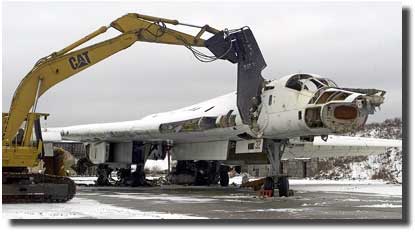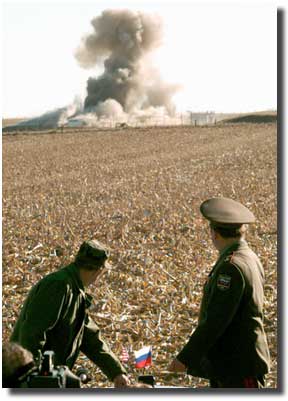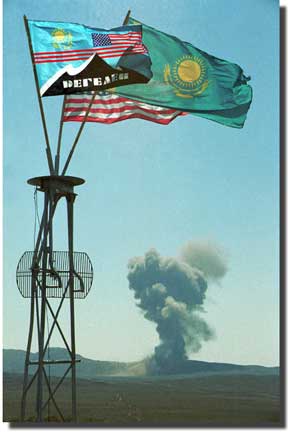
Taking Legislative Aim at Weapons of Mass Destruction
Richard Lugar
![]()
|
The world is awash with nuclear, chemical, and biological weapons and material, says U.S. Senator Richard Lugar, chairman of the Senate Foreign Relations Committee. He is the author of three laws which initiated and then expanded U.S. efforts to help the former Soviet Union "safeguard and dismantle its enormous stockpiles of nuclear, chemical, and biological weapons, as well as its means of delivery and related materials." But more must be done, he asserts, "to control threats from biological and chemical weapons" around the world and to address numerous remaining nuclear proliferation issues—among them, Russian short-range tactical weapons, stockpiles of spent reactor fuel, the absence of nuclear agreements with India and Pakistan, and the need for U.S. and European companies to provide "sustainable private sector jobs" for scientists who otherwise may be "tempted to find work helping others acquire dangerous weapons."
Senator Lugar, a Republican, was first elected to the U.S. Senate from Indiana in 1976 and is the longest-serving U.S. senator in the state's history.
At their recent summit in Bratislava, President Bush and Russia's President Vladimir Putin agreed to conclude cooperative security enhancements at Russia's nuclear warhead—and material—storage facilities by no later than the year 2008. This new, accelerated deadline is a welcome development that underscores the importance of stopping proliferation of weapons of mass destruction (WMD).
Since the fall of the Soviet Union, the proliferation of WMD has been the top national security challenge facing the United States. Unfortunately, few people have recognized this fact. During the 1990s, the nuclear terrorist threat barely registered in surveys of public opinion and, as recently as the 2000 presidential election, neither political party's candidate had clearly stated positions on nuclear terrorism or nonproliferation strategies.
In the face of widespread apathy, the Nunn-Lugar Act, which I co-sponsored with then-Senator Sam Nunn in 1991, has required constant vigilance to obtain funding and support for its work in securing Soviet-era nuclear materials.
|
The attacks of September 11, 2001, and the subsequent revelations about global terrorism changed all that. During the 2004 presidential campaign, President Bush and his main challenger, Senator John Kerry, delivered major speeches on counterproliferation. In their debates, they agreed that our greatest national security threat was weapons of mass destruction falling into the hands of terrorists. The report of the 9/11 Commission, an independent panel that examined the September 11 attacks, noted that "preventing the proliferation of [weapons of mass destruction] warrants a maximum effort" and that "Nunn-Lugar ... is now in need of expansion, improvement, and resources."
A Fourth Installment
Earlier this year, to do just that, I introduced the fourth installment of Nunn-Lugar legislation in Congress. The original initiative, officially named the Cooperative Threat Reduction Program, took effect in 1993 and provided U.S. funding and expertise to help the former Soviet Union safeguard and dismantle its enormous stockpiles of nuclear, chemical, and biological weapons, as well as its means of delivery and related materials. In 1997, Senator Nunn and I, along with Senator Pete Domenici of New Mexico, introduced the Defense Against Weapons of Mass Destruction Act, which expanded Nunn-Lugar's scope in the former Soviet Union and provided WMD expertise to first responders in American cities.
In 2003, President Bush signed the Nunn-Lugar Expansion Act, which authorized Nunn-Lugar to operate outside the former Soviet Union. My new bill will provide more flexibility to pursue Nunn-Lugar projects outside the former Soviet Union, and it will eliminate congressionally imposed conditions on legislation that have impeded time-sensitive projects. We need to cut the red tape and friction within the U.S. government that hinder speedy responses to nonproliferation opportunities.
Despite these achievements and the success at Bratislava, there is much more to do. The world is awash with nuclear, chemical, and biological weapons and materials. Fortunately, the Bush administration is moving on several fronts. In the area of cooperative threat reduction, the president's fiscal year (FY) 2006 budget proposal seeks $415.5 million for Nunn-Lugar, an increase from FY 2005 and enough to carry out all scheduled activities.
Soon after the budget request was released in February 2005, Presidents Bush and Putin announced important steps to increase cooperative efforts to enhance the security of Russia's nuclear stockpile against terrorists. This progress further underscores the need for expanding the Nunn-Lugar program and eliminating the congressionally imposed conditions and certifications that have consistently slowed down implementation of its efforts.
|
Seize the Opportunity
Even as recent international attention has been focused on the nuclear programs in North Korea and Iran, we need to seize this opportunity to control threats from biological and chemical weapons and to make major breakthroughs in the following areas of nuclear proliferation:
|
The window of opportunity to address these threats will not remain open indefinitely. Our political leadership and nonproliferation experts must act now to follow up on the recent summit and work with Russian authorities to unlock the last doors to the dismantlement of its nuclear weapons program. I hope Congress will do its part by passing the new Nunn-Lugar bill to eliminate potential obstacles to the Bratislava timetables. Further, we should scour the globe to identify and create opportunities to dismantle dangerous programs outside the former Soviet Union. Only by working night and day to find and eliminate weapons of mass destruction can we fulfill our obligations to protect the American people and, indeed, the people of all nations.
![]()


